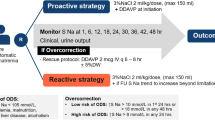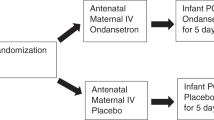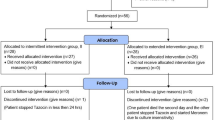Abstract
Study design:
Pilot study.
Objective:
To study the effect of pulsatile bolus infusion of intrathecal baclofen (ITB) on daily ITB dose, in patients showing dose increases, probably due to tolerance.
Setting:
Department of neurology and neurosurgery, University Medical Center Groningen, the Netherlands.
Methods:
Data on dosages and clinical efficacy were gathered from four patients who were switched from continuous to pulsatile bolus infusion of ITB, because of the probable diagnosis of tolerance to ITB.
Results:
Switching from continuous to pulsatile bolus infusion resulted in a decrease of the daily ITB dose, while the clinical effect could be kept stable, without introducing adverse events.
Conclusion:
Pulsatile bolus infusion of ITB seems to be an effective and safe treatment strategy to reverse the need for increasing ITB dosages in patients with the probable diagnosis of tolerance to ITB.
Similar content being viewed by others
Introduction
Intrathecal baclofen (ITB) therapy has proven to be safe and effective in treating severe spasticity that cannot be treated optimally with oral spasmolytic therapy.1, 2, 3 The dose of ITB therapy has shown to increase during the first 12–18 months of therapy, very likely due to optimization of the individual needed dose, after which it stabilizes.2, 4, 5 However, unexplained dose increases may still occur in up to 20% of ITB patients after these first 18 months.4, 6, 7, 8 These dose increases after 18 months are thought to be caused by tolerance, which is one of the major concerns of ITB therapy. Tolerance is defined as a decreasing effect during a stable dose of a drug, requiring a dose increase to produce the same previously obtained effect.9 The hypothesis is that tolerance in ITB therapy is induced by a reduction of the total number of GABAB receptors, and/or by GABAB receptor desensitization.10, 11, 12 The key question is how to treat tolerance in ITB therapy optimally. Altering the infusion mode from simple to complex continuous has shown not to be effective in the development of tolerance.8 The most advocated strategy nowadays is the drug holiday. During a drug holiday, ITB therapy is tapered off and the patient is treated with an alternative spasmolytic drug for days to weeks, until ITB therapy is restarted.8, 13 During this drug holiday the patient has to be monitored carefully, because of the risk of developing baclofen withdrawal symptoms.14 Although the exact mechanism behind a drug holiday is unclear, the GABAB receptors are thought to resensitize for baclofen.
In this paper we present pulsatile bolus infusion as an alternative treatment strategy to reverse ITB dose increases, very likely due to tolerance. During the pulsatile bolus infusion mode, the ITB pump (Synchromed II; Medtronic, Minneapolis, MN, USA) is programmed to deliver the daily baclofen dose in a number of boluses (2–6 per day), instead of delivering ITB continuously.
The purpose of this pilot study was to investigate whether intermittent bolus infusion of ITB would be able to reverse the unexplained dose increases in some patients with continuous ITB infusion, without losing clinical efficacy.
Patients and methods
The departments of neurology and neurosurgery of the University Medical Center Groningen have about 70 patients treated with ITB therapy.
During the last 2 years, four patients were switched from continuous to pulsatile ITB infusion, because of the suggested development of tolerance. Tolerance was defined as an ITB dose increase of at least 100 μg during 1 year, to maintain a stable spasmolytic effect.8 Tolerance was only considered, if no other reasonable explanations, like infections and pain, could be given and after having excluded technical problems with the pump system. Because it has been reported that the ITB dose may increase during the first 12–18 months after implantation, patients were only switched to pulsatile bolus infusion after ⩾18 months of ITB therapy.2, 4, 5, 8
Because an ITB pump cannot be stopped in between boluses, the pump was programmed to deliver the lowest possible continuous rate (‘minimal infusion rate’ which is 3 μg h−1 in case of a baclofen concentration of 1500 μg ml−1). The initial bolus dose was calculated as follows: ((Total Daily Dose−10%−Minimal Infusion Rate)/6). The total continuous daily dose was decreased by 10%, to be cautious, avoiding high peak concentrations from the bolus infusion. The remaining daily dose was divided over six identical boluses, with a bolus interval of 4 h. This was based on the half-life of baclofen (4–5 h) and on own clinical experience, showing a mean duration of effect after an optimal ITB bolus of about 4 h.15, 16 The fixed bolus injection speed of the pump (Synchromed II; Medtronic) resulted in bolus durations between 3 and 5 min, depending on the magnitude of the bolus dose.
During follow-up the optimal bolus doses were adapted if necessary, with 10% increase/decrease of the previous bolus dose; an increase if the spasmolytic effect was considered to be insufficient by the patient, and a decrease if the spasmolytic effect resulted in too much hypotonia, according to the patient.
Follow-up was planned at least every 3 months, for 1 year, rating their spasticity, refilling the pump and adjusting the ITB doses if needed. The clinical efficacy of ITB was measured using the modified Ashworth scale (MAS).17 The primary end point was the mean value of the MAS scores of both knee joints. The MAS was assessed by the same investigator to rule out interrater differences.
Results
Demographics of the four patients who were switched to pulsatile ITB therapy are shown in Table 1.
Figure 1 shows the mean daily ITB dosages (bars) and the clinical efficacy (line) of four patients, with 3-month intervals, during the year before and after the switch to pulsatile ITB infusion.
Patient 1 was switched to pulsatile bolus infusion after an increase of 120 μg per day in 6 months. After the switch to pulsatile bolus infusion, daily ITB dose was stabilized and actually dropped slightly with 20 μg per day (6%), whereas the clinical effect even improved.
Patient 2 showed a rapid dose increase from 175 to 650 μg per day in 12 months, which was necessary to keep the clinical effect stable. After switching to pulsatile bolus infusion, the daily ITB dose dropped with 84 μg per day (13%) and the MAS could be stabilized. Afterwards the ITB dose increased again slightly, but at a much lower rate.
Patient 3 showed an increase of 100 μg ITB during the 3 months before switching to pulsatile bolus infusion. After the switch to pulsatile bolus infusion, daily ITB dose initially dropped with 30 μg per day (6%) and continued to drop during the year hereafter, at the same time showing a clear improvement of the spasticity scores.
Patient 4 was switched to pulsatile bolus infusion, because the daily ITB dose was raised up to 763 μg per day during the years before. However, this dose increase was accompanied by a decrease of the clinical effect, as shown by the increased MAS, up to 4.5 points. After switching to pulsatile bolus infusion, the daily ITB dose dropped to 219 μg per day (29%) and stabilized around 474 μg per day during the first year. The clinical effect improved at the same time, as shown by the reduction of the MAS, from 4.5 to 3.5 points.
All patients experienced drop in their daily ITB dose (6–29%) after having switched to pulsatile bolus infusion. Three patients could be stabilized at this lower dose. Patient 2 only showed a slight dose increase after the switch, although at a much slower rate as compared to the year before the switch. At the same time the clinical effect was improved in three patients and remained stable in one patient (patient 2).
No correlations were found between the effect of pulsatile bolus infusion and the underlying cause of spasticity, neither with the other patient characteristics.
Discussion
Our data show that switching from continuous to pulsatile ITB infusion stabilized or decreased the daily ITB dose in all four patients, at least during the follow-up period of 12 months, whereas the clinical effect remained stable or even improved during the same period.
These are the first data showing that pulsatile ITB infusion may be considered as a useful option to treat tolerance.
Several hypotheses may explain our data
The first hypothesis is related to the dose–effect relationship of ITB. An ITB bolus may provide a better dissemination of baclofen in the cerebrospinal fluid, which correlates with higher concentrations in the spinal cord, compared to continuous infusion.18
The second hypothesis is related to receptor resensitization after pulsatile ITB infusion.19 Bolus infusions very likely cause an increase in the fluctuations of ITB concentrations over time around the catheter tip. These fluctuations may induce receptor resensitization, which could explain the reduction of the overall daily dose of ITB. Whether this hypothesis is correct will remain unclear until we have a better insight into the pharmacokinetics and pharmacodynamics of ITB infusion. This is currently under investigation in our institute. Probably pulsatile bolus infusion may become even more potent by lowering the frequency of boluses per day, to provide longer periods for the GABAB receptors to resensitize. Figure 2 shows modeled spinal ITB concentrations of two infusion regimens, consisting of a t.i.d. bolus regimen as compared to six daily bolus infusions. The concentration swings are apparently bigger in the t.i.d. regimen, which therefore theoretically could induce more resensitization. However, at this moment it is unclear if such a low-frequency ITB bolus regimen will still provide enough clinical benefit for the patients, without producing clinical wearing-off phenomena. A clinical comparison of different bolus regimens will be needed to create practical guidelines for effective infusion schedules of ITB. Based on clinical experience so far, six boluses daily, with 4 h intervals, are at least able to improve tolerance, but we do not know if this regimen is the most effective one.
Comparison of the concentration/time curve of two different bolus regimens. A pulsatile bolus regimen with six boluses (gray line) and a pulsatile bolus regimen with three boluses (black line), both resulting in the same total daily intrathecal baclofen (ITB) dose (this model used an ITB half-life of 4.5 h).
Drug holiday vs pulsatile bolus infusion
Currently, the most advocated strategy to treat tolerance is a drug holiday. During this period of 2–8 weeks, baclofen therapy is tapered off and replaced by other spasmolytic medication, mostly intrathecal morphine (0.5–2 mg per day).13, 20 During a drug holiday, hospital admission is mandatory, because of the risk of baclofen withdrawal syndrome.14 The reported dose reduction after restarting ITB therapy varies significantly, ranging from back to initial post-implantation doses (100–200 mg per day) to even higher doses as compared to the pre-drug-holiday doses.6 Most patients however needed higher doses of ITB within a month after the drug holiday.
Switching to pulsatile ITB infusion does not require admission to the hospital, as there is no risk of a baclofen withdrawal syndrome.
A drug holiday can still be considered if pulsatile bolus infusion does not provide satisfactory results, but may cause significant ITB withdrawal symptoms, which makes it less attractive as first-line therapy.
Conclusion
This pilot study shows that pulsatile bolus infusion seems to be an effective and safe treatment strategy to reverse increasing ITB dosages, probably due to tolerance. Larger pharmacokinetic and pharmacodynamic studies of ITB infusion are needed to support this hypothesis and to create an optimal bolus infusion regimen for patients showing tolerance to ITB therapy.
References
Albright AL, Gilmartin R, Swift D, Krach LE, Ivanhoe CB, McLaughlin JF . Long-term intrathecal baclofen therapy for severe spasticity of cerebral origin. J Neurosurg 2003; 98: 291–295.
Koulousakis A, Kuchta J . Intrathecal antispastic drug application with implantable pumps: results of a 10 year follow-up study. Acta Neurochir Suppl 2007; 97: 181–184.
Penn RD . Intrathecal baclofen for spasticity of spinal origin: seven years of experience. J Neurosurg 1992; 77: 236–240.
Akman MN, Loubser PG, Donovan WH, O'Neill ME, Rossi CD . Intrathecal baclofen: does tolerance occur? Paraplegia 1993; 31: 516–520.
Nielsen JF, Hansen HJ, Sunde N, Christensen JJ . Evidence of tolerance to baclofen in treatment of severe spasticity with intrathecal baclofen. Clin Neurol Neurosurg 2002; 104: 142–145.
Abel NA, Smith RA . Intrathecal baclofen for treatment of intractable spinal spasticity. Arch Phys Med Rehabil 1994; 75: 54–58.
Penn RD, Kroin JS . Long-term intrathecal baclofen infusion for treatment of spasticity. J Neurosurg 1987; 66: 181–185.
Heetla HW, Staal MJ, Kliphuis C, van Laar T . The incidence and management of tolerance in intrathecal baclofen therapy. Spinal Cord 2009; 47: 751–756.
Stevens CW, Yaksh TL . Potency of infused spinal antinociceptive agents is inversely related to magnitude of tolerance after continuous infusion. J Pharmacol Exp Ther 1989; 250: 1–8.
Kroin JS, Bianchi GD, Penn RD . Intrathecal baclofen down-regulates GABAB receptors in the rat substantia gelatinosa. J Neurosurg 1993; 79: 544–549.
Kanaide M, Uezono Y, Matsumoto M, Hojo M, Ando Y, Sudo Y et al. Desensitization of GABA(B) receptor signaling by formation of protein complexes of GABA(B2) subunit with GRK4 or GRK5. J Cell Physiol 2007; 210: 237–245.
Wetherington JP, Lambert NA . GABA(B) receptor activation desensitizes postsynaptic GABA(B) and A(1) adenosine responses in rat hippocampal neurones. J Physiol 2002; 544: 459–467.
Vidal J, Gregori P, Guevara D, Portell E, Valles M . Efficacy of intrathecal morphine in the treatment of baclofen tolerance in a patient on intrathecal baclofen therapy (ITB). Spinal Cord 2004; 42: 50–51.
Coffey RJ, Edgar TS, Francisco GE, Graziani V, Meythaler JM, Ridgely PM et al. Abrupt withdrawal from intrathecal baclofen: recognition and management of a potentially life-threatening syndrome. Arch Phys Med Rehabil 2002; 83: 735–741.
Pohl M, Rockstroh G, Rückriem S, Mehrholz J, Pause M, Koch R et al. Time course of the effect of a bolus dose of intrathecal baclofen on severe cerebral spasticity. J Neurol 2003; 250: 1195–1200.
Sallerin-Caute B, Lazorthes Y, Monsarrat B, Cros J, Bastide R . CSF baclofen levels after intrathecal administration in severe spasticity. Eur J Clin Pharmacol 1991; 40: 363–365.
Bohannon RW, Smith MB . Interrater reliability of a modified Ashworth scale of muscle spasticity. Phys Ther 1987; 67: 206–207.
Bernards CM . Cerebrospinal fluid and spinal cord distribution of baclofen and bupivacaine during slow intrathecal infusion in pigs. Anesthesiology 2006; 105: 169–178.
Cooper JA, Ridley B . Response of intrathecal baclofen resistance to dose reduction. Neurology 2006; 67: 1495–1496.
Coffey JR, Cahill D, Steers W, Park TS, Ordia J, Meythaler J et al. Intrathecal baclofen for intractable spasticity of spinal origin: results of a long-term multicenter study. J Neurosurg 1993; 78: 226–232.
Acknowledgements
We thank CM Kliphuis and DJ van der Sluis (the Department of Neurology, University Medical Center Groningen) for the technical assistance.
Author information
Authors and Affiliations
Corresponding author
Rights and permissions
About this article
Cite this article
Heetla, H., Staal, M. & van Laar, T. Tolerance to continuous intrathecal baclofen infusion can be reversed by pulsatile bolus infusion. Spinal Cord 48, 483–486 (2010). https://doi.org/10.1038/sc.2009.156
Received:
Revised:
Accepted:
Published:
Issue Date:
DOI: https://doi.org/10.1038/sc.2009.156





